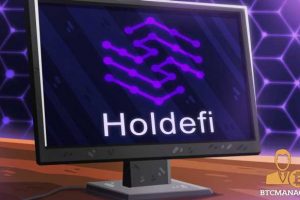Holdefi (HLD) Review: Borrow and Lend Digital Assets Securely

Accessing credit should be easy, better, paperless. However, the current state of affairs in traditional finance is full of needless hops that, as expected, trip potential borrowers.
Decentralized finance (DeFi) is a radical shift away from this style of doing business. Not surprising, the most common form of DeFi is the ability for users to access credit.
Trackers reveal that from the $39 billion of TVL in Ethereum alone, participants prefer supplying assets and borrowing loans from the many DeFi protocols in the expansive smart contracting platform.
What is Holdefi?
Of the many, Holdefi is positioning itself as a suitable alternative to traditional banks. They are currently in the Kovan testnet, being fine-tuned and trialed, but plans to launch on both Ethereum and the Binance Smart Chain at the same time in 2021.
Meanwhile, Holdefi is also conducting a public sale. Considering what they have in store, this may be an opportunity for investors to stack up a token that’s central to a potent project fronted by some of the best brains in crypto, DeFi, and traditional finance.
Holdefi is where token and coin holders can supply (lend) their digital assets and receive superior yields. Here, the lender is providing liquidity to a given pool. At the same time, users can borrow loans from the same pool and repay the principal and interest within a specific period.
The beauty–and the main difference between Holdefi and a traditional bank, is the absence of KYC and paperwork. However, since borrowers are not obligated to submit their personal information, they ought to over-collateralize their loans using digital assets. That means the value of the loan should be lower than the value of the collateral submitted. The goal of this collateral is to ensure that the borrower indeed repays the loan.
Governing the Holdefi protocol are vetted and audited smart contracts. The audit is by Peckshield and Open Zeppelin. They also have a $250k Bounty Program.
Audits and continuous vigilance is essential considering the level of smart contract exploits that have resulted in the loss of millions.
The Holdefi Mechanism
Holdefi mechanism automatically determines the lender and interest rates of the two main parties of the trustless system. These rates are changed every week, with the maximum weekly increase being five percent.
On the other hand, the system limits the maximum borrow interest rate at 30 percent. At the same time, to attract more borrowers and compete with other protocols, the Holdefi system can reduce interest rates.
While automatically determined by the protocol, the lending rate will rise or fall depending on the total supply. On the other hand, borrowers will have to over-collateralize to borrow loans.
The borrower receives POWER directly proportional to the price, the amount of collateral, and the collateral’s Value-to-Loan (VTL) for each collateral deposit. POWER subsequently determines liquidation. They will be collateral liquidation to recoup loan value if the total value of all borrowed assets on one collateral exceeds the collateral power.
Again, the collateral will be sold if it is inactive for over one year. While creators won’t access the collateral, the Holdefi mechanism will automatically liquidate to cover against non-payment. It is mainly in the case of death or the borrower’s inability to pay back loans after an extended period. Also, in case of rapid price fluctuation, the protocol will automatically liquidate collateral.
Holdefi will sell the collateral and impose a penalty (varies depending on the asset borrowed) to the user until power is recovered. Anyone can participate in the collateral auction. A buyer receives a bonus whenever he/she acquires the digital asset.
Unlike other platforms, Holdefi will be separating the supply and collateral pools. Additionally, borrowers can access loans using only one digital asset as collateral. However, each collateral can be used to borrow several different assets.
The HLD Governance Token and Public Sale
The HLD is an ERC-20 and BEP-20 governance token of the Holdefi multi-chain DeFi protocol.
The Holdefi whitelisting is ongoing and will end on Mar 30.
Therefore, HLD holders can participate in the protocol’s governance. For instance, they can determine which new assets to support, proposals on rate changes, collateralization rates, and other protocol-specific refinements may be required.
There are 100 million HLD.
Out of this, two million has been set aside for public sale, where each HLD is available at $0.625, as aforementioned.
All tokens bought during the token sale won’t be locked-up. Moreover, one million HLD tokens will be airdropped via Smart Drop won’t have any lockup. The rest, however, would be locked up for anywhere between six months to four years.
Related posts:
Source: Read Full Article
